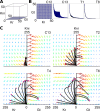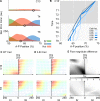A damped oscillator imposes temporal order on posterior gap gene expression in Drosophila
- PMID: 29451884
- PMCID: PMC5832388
- DOI: 10.1371/journal.pbio.2003174
A damped oscillator imposes temporal order on posterior gap gene expression in Drosophila
Abstract
Insects determine their body segments in two different ways. Short-germband insects, such as the flour beetle Tribolium castaneum, use a molecular clock to establish segments sequentially. In contrast, long-germband insects, such as the vinegar fly Drosophila melanogaster, determine all segments simultaneously through a hierarchical cascade of gene regulation. Gap genes constitute the first layer of the Drosophila segmentation gene hierarchy, downstream of maternal gradients such as that of Caudal (Cad). We use data-driven mathematical modelling and phase space analysis to show that shifting gap domains in the posterior half of the Drosophila embryo are an emergent property of a robust damped oscillator mechanism, suggesting that the regulatory dynamics underlying long- and short-germband segmentation are much more similar than previously thought. In Tribolium, Cad has been proposed to modulate the frequency of the segmentation oscillator. Surprisingly, our simulations and experiments show that the shift rate of posterior gap domains is independent of maternal Cad levels in Drosophila. Our results suggest a novel evolutionary scenario for the short- to long-germband transition and help explain why this transition occurred convergently multiple times during the radiation of the holometabolan insects.
Conflict of interest statement
The authors have declared that no competing interests exist.
Figures





Similar articles
-
Speeding up anterior-posterior patterning of insects by differential initialization of the gap gene cascade.Dev Biol. 2020 Apr 1;460(1):20-31. doi: 10.1016/j.ydbio.2019.04.015. Epub 2019 May 7. Dev Biol. 2020. PMID: 31075221
-
A segmentation clock operating in blastoderm and germband stages of Tribolium development.Development. 2012 Dec 1;139(23):4341-6. doi: 10.1242/dev.085126. Epub 2012 Oct 24. Development. 2012. PMID: 23095886 Free PMC article.
-
giant is a bona fide gap gene in the intermediate germband insect, Oncopeltus fasciatus.Development. 2010 Mar;137(5):835-44. doi: 10.1242/dev.045948. Development. 2010. PMID: 20147384 Free PMC article.
-
From development to biodiversity--Tribolium castaneum, an insect model organism for short germband development.Dev Genes Evol. 2008 Apr;218(3-4):119-26. doi: 10.1007/s00427-008-0214-3. Epub 2008 Apr 8. Dev Genes Evol. 2008. PMID: 18392874 Review.
-
The evolution of arthropod segmentation mechanisms.Bioessays. 2004 Oct;26(10):1108-16. doi: 10.1002/bies.20097. Bioessays. 2004. PMID: 15382142 Review.
Cited by
-
Geometric models for robust encoding of dynamical information into embryonic patterns.Elife. 2020 Aug 10;9:e55778. doi: 10.7554/eLife.55778. Elife. 2020. PMID: 32773041 Free PMC article.
-
Classification-Based Inference of Dynamical Models of Gene Regulatory Networks.G3 (Bethesda). 2019 Dec 3;9(12):4183-4195. doi: 10.1534/g3.119.400603. G3 (Bethesda). 2019. PMID: 31624138 Free PMC article.
-
Growth zone segmentation in the milkweed bug Oncopeltus fasciatus sheds light on the evolution of insect segmentation.BMC Evol Biol. 2018 Nov 28;18(1):178. doi: 10.1186/s12862-018-1293-z. BMC Evol Biol. 2018. PMID: 30486779 Free PMC article.
-
Patterning with clocks and genetic cascades: Segmentation and regionalization of vertebrate versus insect body plans.PLoS Genet. 2021 Oct 14;17(10):e1009812. doi: 10.1371/journal.pgen.1009812. eCollection 2021 Oct. PLoS Genet. 2021. PMID: 34648490 Free PMC article. Review.
-
Dynamical modules in metabolism, cell and developmental biology.Interface Focus. 2021 Apr 16;11(3):20210011. doi: 10.1098/rsfs.2021.0011. eCollection 2021 Jun 6. Interface Focus. 2021. PMID: 34055307 Free PMC article.
References
-
- Sander K. Specification of the basic body pattern in insect embryogenesis. Advances in Insect Physiology. 1976;12:124.
-
- Davis GK, Patel NH. Short, long, and beyond: molecular and embryological approaches to insect segmentation. Annual Review of Entomology. 2002;47:669–699. doi: 10.1146/annurev.ento.47.091201.145251 - DOI - PubMed
-
- Lynch JA, El-Sherif E, Brown SJ. Comparisons of the embryonic development of Drosophila, Nasonia, and Tribolium. Wiley Interdisciplinary Reviews: Developmental Biology. 2012;1:16–39. doi: 10.1002/wdev.3 - DOI - PMC - PubMed
-
- Akam M. The molecular basis for metameric pattern in the Drosophila embryo. Development. 1987;101:1–22. - PubMed
Publication types
MeSH terms
Substances
Associated data
LinkOut - more resources
Full Text Sources
Other Literature Sources
Molecular Biology Databases
Miscellaneous

